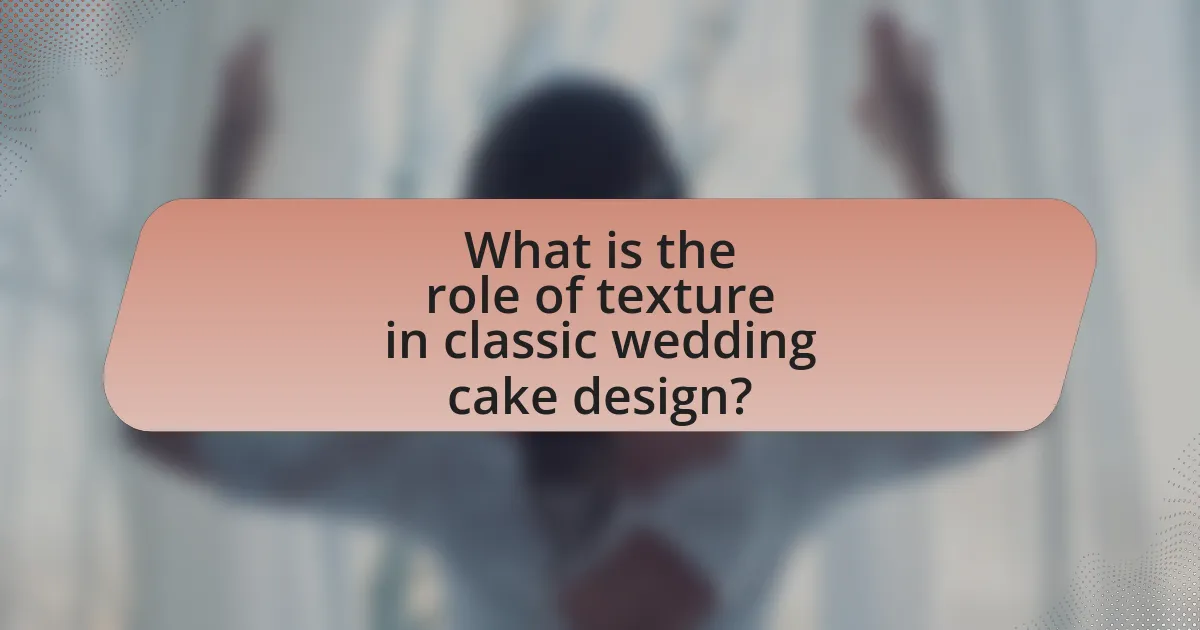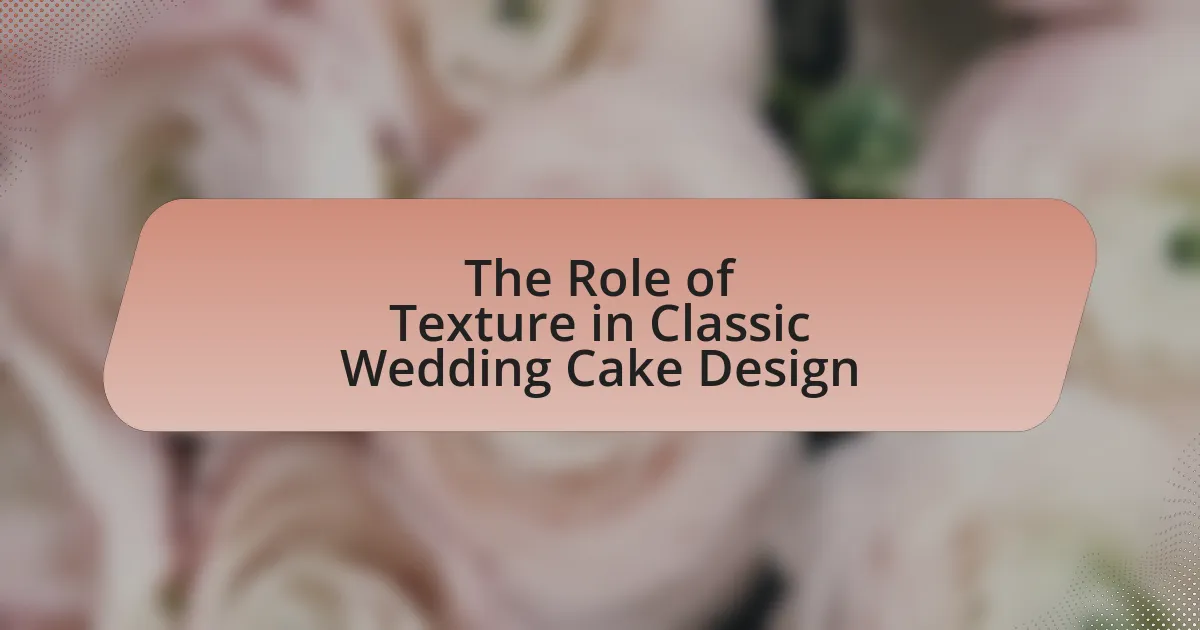The article focuses on the critical role of texture in classic wedding cake design, emphasizing its impact on visual appeal and sensory experience. It explores various textures, such as smooth fondant, ruffled buttercream, and intricate lace, detailing how these elements enhance the cake’s aesthetic and align with wedding themes. Additionally, the article discusses techniques for creating texture, the relationship between texture and flavor perception, and common mistakes to avoid in texture integration. Overall, it highlights the importance of texture in achieving a cohesive and memorable wedding cake design.

What is the role of texture in classic wedding cake design?
Texture plays a crucial role in classic wedding cake design by enhancing visual appeal and creating a multi-sensory experience. The use of various textures, such as smooth fondant, intricate piping, or rustic buttercream, adds depth and interest to the cake’s appearance, making it more visually striking. Additionally, texture influences the perception of flavor and mouthfeel; for instance, a cake with a rough, textured surface may suggest a more homemade or artisanal quality, while a sleek, polished finish can convey elegance and sophistication. Historical trends in wedding cake design, such as the Victorian era’s emphasis on elaborate textures, demonstrate how texture has been a key element in defining the aesthetic and cultural significance of wedding cakes over time.
How does texture influence the overall aesthetic of a wedding cake?
Texture significantly influences the overall aesthetic of a wedding cake by adding depth, visual interest, and a tactile experience. Different textures, such as smooth fondant, ruffled buttercream, or intricate lace patterns, create distinct visual effects that can enhance the cake’s elegance and align with the wedding theme. For instance, a cake with a smooth finish may convey a modern and sophisticated look, while a textured surface can evoke a more rustic or vintage feel. Studies in culinary arts emphasize that texture not only affects appearance but also impacts perception of flavor, making it a crucial element in cake design.
What are the different types of textures used in wedding cake design?
Different types of textures used in wedding cake design include smooth, ruffled, quilted, and lace textures. Smooth textures are achieved through fondant or buttercream, providing a sleek appearance. Ruffled textures involve layers of icing or fondant that create a soft, romantic look. Quilted textures feature a diamond pattern, often achieved with a fondant impression mat, adding elegance. Lace textures mimic intricate lace designs, often created with edible lace or piping techniques, enhancing the cake’s sophistication. Each texture contributes to the overall aesthetic and theme of the wedding cake, allowing for personalization and creativity in design.
How do textures enhance the visual appeal of wedding cakes?
Textures enhance the visual appeal of wedding cakes by adding depth and dimension, making them more visually interesting. The use of various textures, such as smooth fondant, ruffled buttercream, or intricate lace patterns, creates contrast that draws the eye and elevates the overall design. For instance, a cake with a combination of glossy and matte finishes can create a striking visual effect, while textured elements like sugar flowers or piped details can add a tactile quality that invites closer inspection. This interplay of textures not only enhances aesthetics but also reflects the couple’s style and theme, making the cake a focal point of the wedding celebration.
Why is texture important in the context of wedding cake themes?
Texture is important in the context of wedding cake themes because it enhances visual appeal and contributes to the overall sensory experience. The interplay of different textures, such as smooth fondant, ruffled buttercream, or intricate lace designs, can create a striking aesthetic that aligns with the wedding’s theme. For instance, a cake with a combination of glossy and matte finishes can evoke elegance, while a rustic, textured cake can reflect a more casual or vintage atmosphere. Additionally, texture influences the perception of flavor; a cake with varied textures can provide a more complex and enjoyable tasting experience, making it memorable for guests.
How does texture complement various wedding themes and styles?
Texture enhances various wedding themes and styles by adding depth, visual interest, and tactile appeal to the overall design. For instance, a rustic wedding theme benefits from rough, natural textures like burlap and wood, which evoke a warm, organic feel. In contrast, a modern wedding style often incorporates sleek, smooth textures such as fondant or metallic finishes, creating a sophisticated and polished look. Textural elements like ruffles, lace, or geometric patterns can also be tailored to reflect the couple’s personality and the wedding’s aesthetic, making the cake a focal point that harmonizes with the overall decor. This alignment between texture and theme not only elevates the visual experience but also reinforces the emotional resonance of the celebration.
What role does texture play in creating a cohesive wedding cake design?
Texture plays a crucial role in creating a cohesive wedding cake design by enhancing visual interest and contributing to the overall aesthetic harmony. Different textures, such as smooth fondant, ruffled buttercream, or intricate lace patterns, can complement each other and reflect the wedding theme, making the cake a focal point of the celebration. For instance, a combination of matte and glossy finishes can create depth, while contrasting textures can draw attention to specific design elements, ensuring that the cake aligns with the couple’s style and the event’s atmosphere.
What techniques are used to create texture in wedding cakes?
Techniques used to create texture in wedding cakes include fondant smoothing, ruffling, piping, and the use of edible lace. Fondant smoothing involves applying a layer of fondant and using tools to create a sleek surface, while ruffling adds dimension through layered fondant or buttercream. Piping techniques, such as rosettes or lace patterns, enhance visual interest and depth. Edible lace, made from a mixture of sugar and other ingredients, can be applied to create intricate designs. These methods are widely recognized in cake decorating and contribute significantly to the overall aesthetic of wedding cakes.
What are the most popular methods for adding texture to cake surfaces?
The most popular methods for adding texture to cake surfaces include fondant, buttercream, ganache, and various decorative techniques such as piping and embossing. Fondant provides a smooth, polished finish that can be shaped into intricate designs, while buttercream can be textured using spatulas or piping tips to create swirls and patterns. Ganache, when poured over a cake, can create a glossy, textured surface. Additionally, techniques like using stencils or textured mats can imprint designs onto the cake, enhancing its visual appeal. These methods are widely used in cake decorating, particularly in wedding cake design, to create a sophisticated and elegant look.
How do decorators achieve intricate textures on wedding cakes?
Decorators achieve intricate textures on wedding cakes primarily through techniques such as fondant draping, piping, and the use of textured molds. Fondant draping allows for smooth, elegant surfaces that can be manipulated into various shapes, while piping techniques create detailed designs like lace or floral patterns. Textured molds, often made from silicone, enable decorators to imprint complex designs onto the cake’s surface, enhancing visual appeal. These methods are widely recognized in the cake decorating community for their effectiveness in creating visually stunning and tactile elements, contributing significantly to the overall aesthetic of wedding cakes.
How can texture affect the taste and experience of a wedding cake?
Texture significantly influences the taste and overall experience of a wedding cake by affecting mouthfeel and flavor perception. For instance, a cake with a light, airy texture can create a sensation of delicacy, enhancing the enjoyment of flavors like vanilla or lemon, while a dense, moist cake can provide a rich, satisfying experience that complements flavors such as chocolate or spice. Research indicates that texture can alter taste perception; for example, a study published in the journal “Food Quality and Preference” found that texture impacts how sweetness and flavor intensity are perceived, suggesting that a well-balanced texture can elevate the overall enjoyment of the cake. Thus, the interplay between texture and flavor is crucial in creating a memorable wedding cake experience.
What textures contribute to the overall flavor profile of a wedding cake?
The textures that contribute to the overall flavor profile of a wedding cake include moistness, density, and crumb structure. Moistness enhances the cake’s richness and prevents it from feeling dry, which is essential for a pleasurable eating experience. Density affects the cake’s mouthfeel; a denser cake can provide a more substantial bite, while a lighter cake may feel airy and delicate. Crumb structure, which refers to the size and distribution of air pockets within the cake, influences how flavors are perceived, as a finer crumb can lead to a more uniform flavor experience. These textures work together to create a harmonious balance that enhances the overall enjoyment of the wedding cake.
How does the texture of frosting impact the cake’s taste experience?
The texture of frosting significantly impacts the cake’s taste experience by influencing mouthfeel and flavor perception. A smooth, creamy frosting can enhance the overall enjoyment by providing a rich, velvety sensation that complements the cake’s moisture and density. In contrast, a grainy or overly thick frosting may detract from the cake’s flavors, creating an unbalanced taste experience. Research indicates that texture plays a crucial role in flavor release; for instance, a study published in the journal “Food Quality and Preference” found that smoother textures are often associated with higher sweetness perception, thereby enhancing the overall flavor profile of desserts. Thus, the texture of frosting is essential in shaping the sensory experience of cake consumption.
What are some common mistakes to avoid when incorporating texture in wedding cake design?
Common mistakes to avoid when incorporating texture in wedding cake design include overloading the cake with too many textures, which can create visual chaos and detract from the overall aesthetic. Additionally, failing to consider the cake’s flavor profile when choosing textures can lead to an unbalanced experience; for example, pairing a rough texture with a delicate flavor may clash. Another mistake is neglecting the harmony between the cake’s textures and the wedding theme, as mismatched styles can confuse the design. Lastly, not testing the durability of textured elements can result in structural failures during the event, as certain textures may not hold up well over time. These considerations are essential for achieving a cohesive and visually appealing wedding cake design.
How can improper texture choices detract from a wedding cake’s appeal?
Improper texture choices can significantly detract from a wedding cake’s appeal by creating an unbalanced visual and sensory experience. For instance, a cake with a rough or overly dense texture may appear uninviting and fail to convey the elegance typically associated with wedding cakes. Additionally, mismatched textures, such as pairing a smooth fondant with a coarse cake, can disrupt the overall aesthetic harmony, leading to a less appealing presentation. Research indicates that texture influences taste perception; thus, an inappropriate texture can also negatively impact guests’ enjoyment, making the cake less memorable.
What tips can help ensure successful texture integration in wedding cakes?
To ensure successful texture integration in wedding cakes, bakers should focus on balancing different textures through careful layering and ingredient selection. Utilizing a combination of moist cake layers, creamy fillings, and textured frostings creates a harmonious mouthfeel. For instance, incorporating elements like crunchy nuts or smooth ganache can enhance the overall experience. Additionally, using tools such as textured rolling pins or combs can add visual interest to the frosting, further contributing to the cake’s texture. Research indicates that texture plays a crucial role in consumer preference, with studies showing that cakes with varied textures are often rated higher in taste satisfaction.
